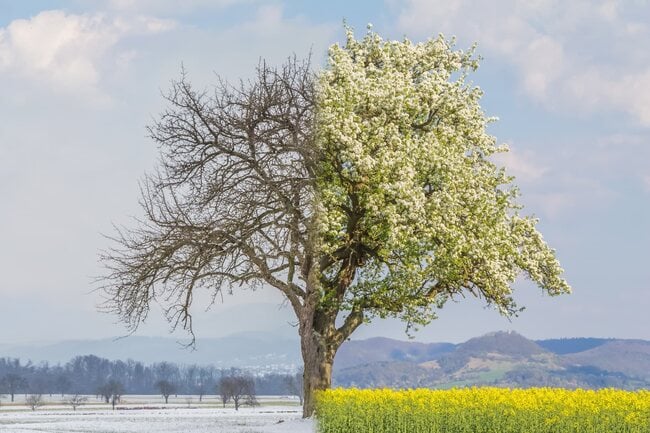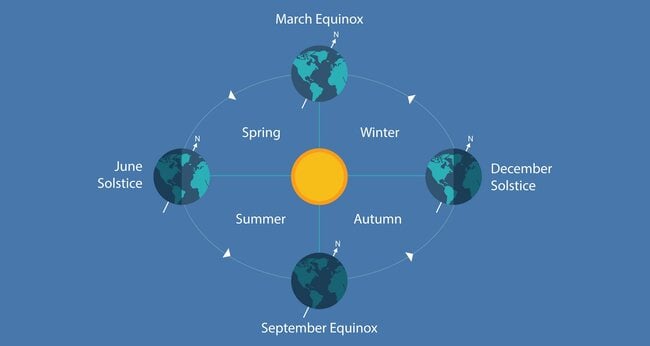What Are Meteorological Seasons Vs. Astronomical Seasons?

Did you know that meteorologists define seasons differently than the average person? The seasons you are familiar with, according to the calendar, are “astronomical,” but the seasons that your meteorologist chats about on the evening news are “meteorological.”
For meteorologists, the seasons are defined by the months with temperatures and weather often associated with each. Summer, for example, runs from June through August, when temperatures feel most like “summer.”
The four meteorological seasons
- Spring – Begins March 1 (March, April, May); ends May 31.
- Summer – Begins June 1 (June, July, August); ends August 31.
- Fall – Begins September 1 (September, October, November); ends November 30.
- Winter – Begins December 1 (December, January, February); ends on the last day in February.
Seasons As We Know Them
Astronomers, on the other hand—like most people—define the seasons by the position of the Sun and the Earth’s tilt. (See the illustration below.) Winter in the Northern Hemisphere begins when the noontime Sun reaches its farthest point south in the sky or when the Sun’s rays shine down from a point directly overhead as seen from the tropic of Capricorn (latitude 23.5 degrees south), known as the winter solstice. This happens on December 21 (or December 22, depending on the year). Later in the year, when the noontime Sun shines down on the equator at vernal or spring equinox, spring begins.

- Spring begins with the vernal equinox. At this point, the Earth moves from its maximum tilt away from the Sun to a point that is of equal distance from the Sun. The noontime Sun’s rays aim directly at the equator.
- Summer begins with the summer solstice. The Earth tilts farthest toward the Sun, and its rays are aiming directly at northern latitudes.
- Fall begins with the autumnal equinox. At this point, the Earth tilts away from its maximum lean toward the Sun, the opposite of its position in spring. Its rays aim directly at the equator.
- Winter begins with the winter solstice. The Earth tilts away from the Sun, and the Sun’s rays aim directly at southern latitudes.
Join The Discussion
What do you think? Should March 1 be the official start to spring and December 1, winter?
Share your thoughts in the comments below!
This article was published by the staff at Farmers' Almanac. Do you have a question or an idea for an article? Contact us!







I tried to join the “discussion”.
But my entry has been dismissed. With no explanation (even sent bcc to me by e-mail).
I guess my entry didn’t belong.
Think about how pathetic that is.
Malcolm,
Comments are reviewed and approved to avoid spam. Your comment was not “dismissed”.
Meteorological seasons are by far the best measurement for weather and climate. In most temperate regions….Northern hemisphere for example, the average maximum temperate peaks on around July 15th…6 weeks after June 1 and 6 weeks before Aug 31st. Same applies to each seasonal change…In january the coldest averages occur right on Jan 15th….6 weeks after Dec 1 and 6 weeks before Feb 28/9…
Thank you for sharing this information!
So you’re telling me that out of the blue the calendar derived by humans fits exactly with nature all the way through the year, all four seasons, year after year. I simply don’t believe you. Different years are different. Very different.
In fact, recently, nature has changed the way it is working over time throughout the year. Looking at an historical average isn’t working like it used to.
I think the seasons should start and end with the solstices and equinoxes. Let’s use nature as our guide.
We tend to agree! Makes sense. Thanks for sharing your thoughts here.
I think it should be left alone
i agree with you
I think the seasons should start and end with the solstices and equinoxes. Most years, (this one may be an exception), we have several winter weather days after March 1 and we have lots of days in the 90s after Sept. 1. The day that the earth begins to tilt the opposite direction is a good marker for a season change.
The weather certainly is changing but tradition seems to be the way to go. Thanks for sharing your thoughts here.
Sorry..but in most temperate regions….Northern hemi, the average maximum temperate peaks on around July 15th…6 weeks after June 1 and 6 weeks before Aug 31st. Same applies to each seasonal change…
Spring starts when the Circus are out
Summer starts, when you go out in shirt sleeves.
Autumn, when the leaves fall off.
Winter ,when it’s cold
Yeo, I say leave things alone. They are the way they are for a reason. We never should have let our gubmint start dictating things with “daylight savings time”, what a crock. Mother nature will do whatever it is she’s gonna do, and nothing man can do will ever change that. Same with this new “greenie revolution crap”. The earth has taken care of itself for a long time, just let it be, I say!
I say leave things alone
It totally makes sense.